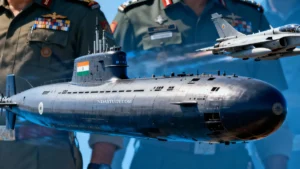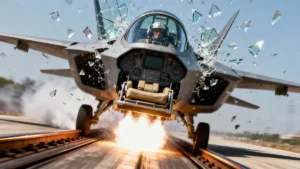Defence sector in 2025 (Report) – India’s defence ambitions are increasingly prominent on the global stage. As of 2025, it is the third-largest military spender, with a defence budget exceeding 2% of GDP. This commitment underscores the need to secure its borders and assert regional influence. However, nearly 60% of the Indian Army’s critical equipment is classified as “vintage,” and significant modernisation projects, such as advanced fighter jets and next-generation artillery, face delays of three to five years. These challenges pose serious risks in a landscape marked by complex security threats and rapidly modernising adversaries.
This article explores the core of India’s defence sector in 2025, highlighting the contradiction of increasing budgets alongside operational challenges. We will analyse the current modernisation efforts, the effects of procurement delays, and the transformative potential of the Make in India and Atmanirbhar Bharat initiatives. With data-driven insights and expert opinions, discover how India is working to turn its defence aspirations into reality, as well as the obstacles that still hinder true self-reliance and security.
India’s Defence Modernisation: 2025 Snapshot
India’s defence sector in 2025 shows the country’s strong focus on security and technology. Over the past ten years, India’s defence budget has grown by more than 160%. It increased from ₹2.47 trillion in 2015 to ₹6.81 trillion (about US$81 billion) in 2025. This is a 9.5% rise compared to last year. As a result, India is now the third-largest military spender in the world. This spending reflects India’s goals in the region and the need to update its armed forces.
Data Chart: Defence Budget Growth (2015–2025)
| Year | Defence Budget (₹ Trillion) | % Increase YoY |
|---|---|---|
| 2015-16 | 2.47 | 7.9% |
| 2016-17 | 2.49 | 0.8% |
| 2017-18 | 3.60 | 44.7% |
| 2018-19 | 4.04 | 12.2% |
| 2019-20 | 4.31 | 6.6% |
| 2020-21 | 4.71 | 9.3% |
| 2021-22 | 4.78 | 1.5% |
| 2022-23 | 5.25 | 9.8% |
| 2023-24 | 5.94 | 13.1% |
| 2024-25 | 6.21 | 4.6% |
| 2025-26 | 6.81 | 9.5% |
Ten Years of Remarkable Growth (Source: Ministry of Defence, PRS India, Macrotrends, ISSI)
Key Modernisation Programs: Turning Ambition into Action
A mix of high-profile acquisitions and indigenous innovation powers India’s modernisation drive:
- Rafale Fighter Jets: The induction of Rafale jets has boosted the Indian Air Force’s combat capabilities, setting new benchmarks for air superiority.
- Tejas Light Combat Aircraft: The indigenous Tejas program is a Make in India success story, with the Mark 1A variant now entering squadron service and export prospects rising.
- S-400 Missile Systems: The deployment of the S-400 Triumf air defence system has significantly strengthened India’s air defence shield.
- Arjun Mk-1A Tanks: The domestically developed Arjun Mk-1A main battle tank is being inducted, reflecting India’s growing capabilities in armoured platforms.
Indigenous Manufacturing & Technology Upgrades: The Atmanirbhar Bharat Push
The 2025 budget allocates 75% of modernisation funds for domestic procurement, marking a historic high. This shift has sparked a surge in indigenous manufacturing, with the Defence Research and Development Organisation (DRDO) receiving a 10% budget increase, raising its allocation to ₹26,816 crore for advanced research and development. Some of the major successes include:
- BrahMos Supersonic Missiles: Co-developed with Russia, now being exported to Southeast Asia.
- Pinaka Rocket Systems: Indigenous multi-barrel rocket launchers deployed along sensitive borders.
- Advanced Electronics & UAVs: India’s push into AI, cyber defence, and unmanned systems is accelerating, with new startups and private players entering the ecosystem.
The Procurement Puzzle: Delays & Their Impact
In 2025, India’s defence sector faces a major problem. The defence budget has reached historic highs, but major procurement projects are delayed by 3 to 5 years on average. These delays are not just numbers; they leave soldiers with outdated equipment. This weakens the country’s security, especially with rising regional tensions.
Data Snapshot: Average Delay in Major Defence Procurements
- Average delay in major acquisition projects: 3–5 years
- Percentage of Army equipment classified as “vintage”: Nearly 60%
- Key projects delayed: Artillery systems, fighter jets, naval assets
Also Read: IAF Jaguar Crash in Jamnagar
Case Studies: Delayed Artillery & Fighter Jet Acquisitions
Artillery Modernisation:
India’s pursuit of modern artillery began in the 1980s. However, the induction of new howitzers, such as the M777 and the K9 Vajra, only gained momentum in the late 2010s. Even now, achieving full operational capability has been delayed by several years, with indigenous projects experiencing repeated extensions.
Fighter Jet Acquisition:
The Indian Air Force’s initiative to replace its ageing MiG-21 fleet has faced setbacks due to delays in both international procurement, such as the Rafale deal, and indigenous programs like the Tejas Mk-1A. Consequently, the current number of operational squadrons remains below the sanctioned levels, which impacts air superiority and the capability for rapid response.
Expert Quote: Systemic Bottlenecks
“Procurement delays in India’s defence sector are rooted in complex approval chains, frequent policy changes, and a lack of coordination between stakeholders. These systemic bottlenecks not only inflate costs but also erode operational readiness, leaving our forces at a disadvantage.”
— Defence Analyst, Centre for Policy Research
Also Read: How India’s Defence Budget Is Set to Double by 2030 [Expert Analysis]
Impact on Operational Readiness and Morale
Delays have serious effects.
- Operational Gaps: Outdated artillery and aircraft limit India’s ability to respond swiftly to emerging threats.
- Morale: Troops operating with obsolete equipment face greater risks, impacting morale and confidence.
- Strategic Setbacks: Delays undermine India’s ambitions for self-reliance and global defence leadership.
Budget Allocations: Where Does the Money Go?
India’s defence budget for 2025-26 has reached a record ₹6.81 lakh crore (US$78.8 billion), representing a 9.5% increase from the previous year. This is the largest allocation among all government ministries. However, a critical question arises: How much of this unprecedented budget is dedicated to modernisation, and how much is simply allocated to maintain the existing system?
The Defence Budget’s Hidden Story—Numbers That Shape India’s Security
Manu, Co-Founder of NDA Study
Breakdown of 2025 Defence Budget
| Category | Amount (₹ Crore) | Share of Total (%) |
|---|---|---|
| Revenue Expenditure | 3,11,732 | 45.8 |
| Capital Outlay (Modernisation) | 1,80,000 | 26.4 |
| Defence Pensions | 1,60,795 | 23.6 |
| MoD (Civil) | 28,683 | 4.2 |
| Total | 6,81,210 | 100 |
Analysis: Revenue vs. Capital—A Persistent Imbalance
- Revenue Expenditure (₹3.11 lakh crore, 45.8%):
This includes pay, allowances, training, maintenance, and daily operations. It also covers logistics and food costs—these are essential but not game-changing. - Defence Pensions (₹1.61 lakh crore, 23.6%):
Due to the One Rank One Pension scheme and an increasing number of veterans, pension costs now account for nearly a quarter of the total budget. - Capital Outlay (₹1.8 lakh crore, 26.4%):
This initiative serves as the foundation for modernisation by funding new aircraft, warships, advanced weaponry, and infrastructure. Importantly, 75% of this capital expenditure is allocated for indigenous procurement, enhancing the Make in India and Atmanirbhar Bharat missions.
Although capital expenditure has increased, it is still outpaced by revenue and pension spending. Additionally, some modernisation funds were unspent last year due to procurement delays and procedural bottlenecks.
Implications for Long-Term Capability Building
- Modernisation at Risk:
India has less than one-third of its budget for buying new military equipment. This limits the country’s ability to quickly upgrade its armed forces. Delays in spending slow down the process of acquiring advanced equipment. - Personnel Welfare vs. Modernisation:
The increasing pension costs demonstrate a commitment to veterans, but they redirect funds from critical technology upgrades and new platforms. - Push for Self-Reliance:
The government’s decision to allocate 75% of modernisation funds for domestic(Indigenous) procurement indicates a strong commitment to indigenous innovation; however, success depends on streamlining procurement processes and accelerating project execution.
The Stakes Behind the Numbers:
Every rupee spent on salaries and pensions honours India’s soldiers and veterans. However, not investing in modernization puts our future security at risk. As threats change, India must make an important choice: stick with the current system or invest more in creating a self-reliant military that is ready for the future.
Make in India & Atmanirbhar Bharat: Progress and Pitfalls
Note: India’s Defence Revolution—From Import Dependence to Indigenous PowerIn just five years, India’s defence sector has undergone a significant transformation. In 2020, only 58% of the Ministry of Defence’s procurement budget was allocated to indigenous products. By 2025, that figure has increased to a record 75%. This change has been driven by the initiatives “Make in India” and “Atmanirbhar Bharat.” This impressive progress is not merely a matter of statistics; it reflects India’s growing confidence in designing, building, and exporting world-class weaponry, all while addressing the ongoing challenges associated with rapid change.
Indigenous Procurement—2020 vs. 2025
| Year | Share of Indigenous Procurement (MoD Acquisition Budget) |
|---|---|
| 2020 | 58% |
| 2025 | 75% |
- Indigenous defence production in 2023-24 is projected to reach ₹1,27,434 crore, representing a 174% increase from ₹46,429 crore in 2014-15.
- Defence exports for the fiscal year 2024-25 are estimated to be ₹23,622 crore, which is approximately US$2.8 billion.
Success Stories: BrahMos, Pinaka, Akash & More
- BrahMos Supersonic Missile: Co-developed with Russia, it is now exported to Southeast Asia and serves as a global benchmark for precision strike capability.
- Pinaka Rocket System: Indigenous multi-barrel launcher, now a mainstay on sensitive borders, with export potential.
- Akash Surface-to-Air Missile: Deployed throughout the armed forces and exported to several countries, this showcases India’s air defence capabilities.
- Other Achievements: Dhanush and ATAGS artillery, Arjun MBT, Tejas LCA, along with a growing ecosystem of advanced electronics, UAVs, and radars.
Challenges: Technology Gaps, Private Sector, and FDI Limits
Despite this progress, significant hurdles remain:
- Technology Gaps: India continues to depend on imports for advanced engines, sensors, and critical subsystems. Although indigenous content is increasing, it often omits the most sophisticated components.
- Private Sector Participation: Although private companies are securing more contracts, public sector undertakings still dominate, limiting competition and innovation.
- FDI Limits: Foreign Direct Investment in defence is limited to 74% (automatic route), which may discourage global companies from transferring advanced technology or establishing large-scale manufacturing.
“Atmanirbhar Bharat has given an unprecedented boost to India’s defence ecosystem, but the real test is sustaining this momentum. To become a true global player, we must close technology gaps, empower private industry, and make India a hub for defence innovation and exports.”
— Senior Defence Industry Executive
The Way Forward: Strategies for a Stronger Defence Sector
In 2025, India’s defence sector is poised for transformation. Despite a record allocation of ₹6.81 lakh crore, which represents a 9.5% increase from the previous year, ongoing threats and rapid technological advancements require more than just larger budgets. The future of India’s security hinges on bold reforms, continuous innovation, and a united determination to achieve true self-reliance.
Policy Recommendations: Building a Modern, Agile Defence Ecosystem
- Streamline Procurement Processes
India’s defence procurement faces delays due to complex approvals and policy shifts. Simplifying procedures, enforcing strict timelines, and using digital platforms can reduce red tape and accelerate modernisation. - Boost Investment in R&D and Innovation
India should invest in AI, quantum computing, and autonomous systems, establish research hubs, and support defence start-ups to boost local innovation and capabilities. - Foster Public-Private Partnerships
Collaboration among the public sector, private industry, and academia drives the defence sector. The Defence Industrial Corridors and over 600 licenses since 2020 have fostered growth. Simplifying procurement and promoting joint ventures will enhance competitiveness and exports.
Future Outlook: AI, Cyber Defence, and Next-Gen Warfare
India’s military modernisation is set to accelerate with a focus on:
- Artificial Intelligence & Autonomous Systems: From unmanned drones to predictive battlefield analytics, artificial intelligence (AI) will transform surveillance, logistics, and combat.
- Cyber Defence: As digital threats increase, strong cyber capabilities are essential to safeguard command networks and national infrastructure.
- Integrated Theatre Commands: The implementation of unified commands will improve force deployment and foster cooperation among the Army, Navy, and Air Force.
- Defence Exports & Global Partnerships: With exports expected to reach ₹35,000 crore by 2025, India is set to become a significant player in the global arms market, enhancing its strategic influence.
Author’s Word
India’s defence sector in 2025 stands at a pivotal moment, marked by impressive progress, yet shadowed by persistent challenges. India’s defence budget has reached a record ₹6.81 lakh crore, reflecting a commitment to military modernisation and reduced import reliance. Initiatives like Make in India and Atmanirbhar Bharat have increased domestic procurement to 75% and boosted defence exports. Advanced systems such as BrahMos, Akash, and Pinaka highlight India’s technological progress.
India’s defence sector faces significant challenges due to bureaucratic delays and limited research and development (R&D) funding, with only ₹1.8 lakh crore allocated for modernisation. To tackle both external and internal security threats, India needs to focus on innovation, streamline its procurement processes, increase investments in R&D, and strengthen public-private partnerships. Addressing these issues is essential for achieving true self-reliance in defence.
Stay Tuned & Stay Connected!
![India’s Defence Sector in 2025: Progress, Challenges & The Road Ahead[ Exposed ] 1 India’s Defence Sector in 2025](https://ndastudy.com/wp-content/uploads/2025/06/Indias-Defence-Sector-in-2025.webp)











